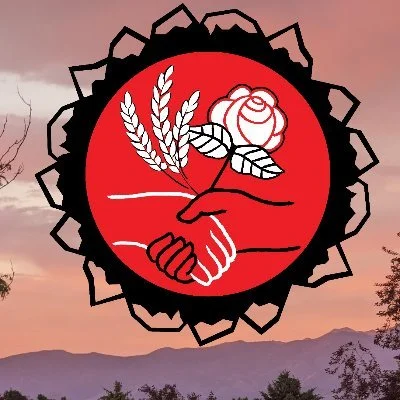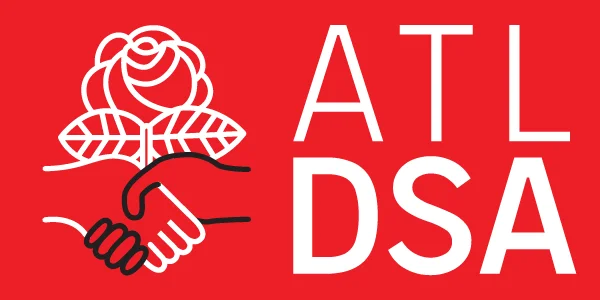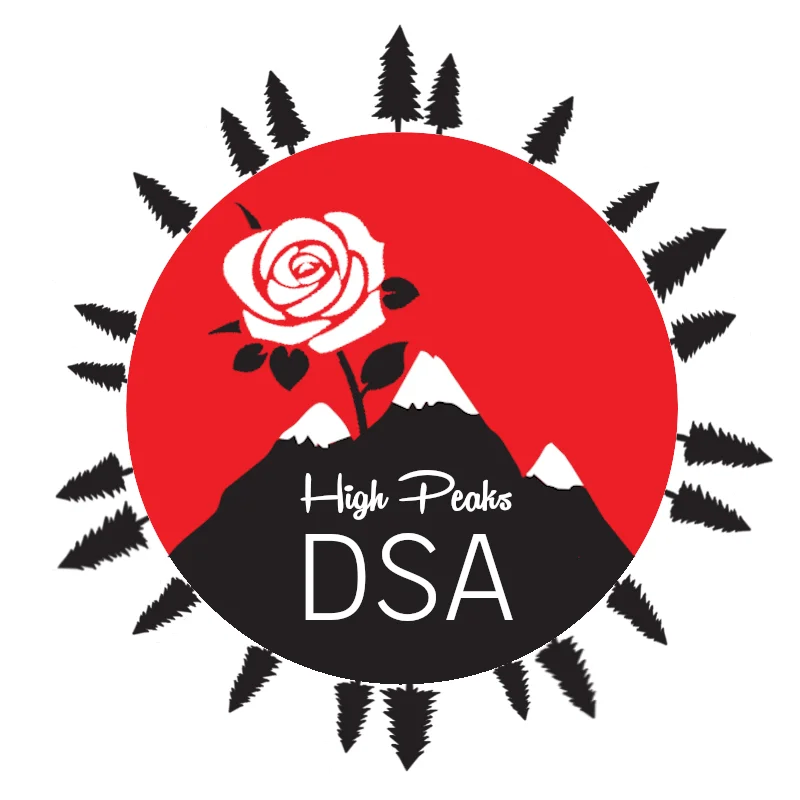

Protected: April 2021 Regular Meeting Minutes
This post is password protected. You must visit the website and enter the password to continue reading.


Resolution Supporting the DSA Pass the PRO Act Campaign
On Sunday, April 11th, the members of Charlotte Metro DSA voted to endorse the National DSA Pass the PRO Act Campaign. The full text of the resolution is available below.
As a top national priority, DSA is embarking on a national campaign to pass the Protecting the Right to Organize Act (PRO Act). This transformative legislation gives power to unions to organize workers and overturns many anti-labor rulings handed down by the Supreme Court. Most importantly, it roots out racist and unjust labor practices, like right-to-work laws, and guarantees that immigrant workers have the same rights afforded to their fellow workers. DSA is joining a national coalition led by the International Union of Painters and Allied Trades (IUPAT), a union that is majority people of color, who has been leading the push. DSA’s National Political Committee is preparing to support DSA chapters in every state as we fight side by side with workers everywhere from now until May Day (Biden's 100th day in office) to force the president and federal elected officials to make this legislation a reality.
President Biden has made climate one of his key priorities in office. In his first week in office, he’s already re-entered the Paris Agreement and cancelled the Keystone pipeline. These steps re-establish the status quo of Obama’s presidency. But more importantly, the new administration's emphasis on climate, along with more socialists in Congress, creates openings for DSA to push for key legislative priorities. There is also a common desire among both labor and the left to not repeat 2008, when Obama was allowed to back down on his promises, leading to the Republican wave in 2010.
We can only win transformative reforms like the Green New Deal with a much stronger, radicalized, and organized working class. To that end, DSA’s national Green New Deal (GND) campaign and Democratic Socialist Labor Commission (DSLC) are convening a central push for the First 100 Days of the new administration to pass the PRO Act (Protect the Right to Organize), which would strengthen unions and the power of the working class to organize on the job, helping to build labor power as strong as it needs to be in the months and years ahead to win a just transition to a green economy for all workers, especially in building power toward GND demands like a federal jobs guarantee that can function as socialist “non-reformist reforms.” The original New Deal was won through militant labor organizing — rebuilding this capacity is crucial to the theory of power DSA’s national GND campaign has developed for a radical Green New Deal.
Towards that end, Charlotte Metro DSA proposes to work within our chapter to mobilize members around the PRO Act, which would begin with emphasizing that passing this legislation is a first key demand within a larger campaign strategy to win a Green New Deal. We will coordinate our chapter with the broader DSA national initiative, laying the groundwork for future efforts strengthening connections between labor and climate justice.
Goals:
Align DSA members around a labor-oriented strategy for climate organizing;
Advance a pro-labor narrative for DSA’s climate organizing, internally and externally;
Connect with and activate DSA union members to participate in a strategic and federally-targeted DSA campaign;
Activate non-union worker members within DSA around the demand of the PRO Act;
Increase DSA members’ capacity/skills to carry out strategic organizing work with federal targets in a strategic nationwide campaigns;
Work with Labor WG to ID union members and non-union members in key sectors that would be affected by PRO for mobilization, laying the groundwork for possible future GND-related organizing with local labor unions;
Support chapter targeting of local unions who could be brought into coalition around the PRO Act and facilitate longer-term relationship building with labor.
To this end, we are proposing these chapter efforts for the first 100 days of the Biden administration:
Plan public-facing political education events around the role of organized labor and the PRO Act in winning a Green New Deal;
Mobilize members for national webinars around PRO Act and the role of organized labor in a just transition;
Participate in DSA national phone banks with auto-dialer campaign to pressure key Reps in Congress, especially in strategic states and districts with Reps and Senators to be moved in key states like Virginia, West Virginia, Georgia, Colorado, and Arizona;
The National GND campaign is developing a congressional tracking sheet with IUPAT to identify priority targets. We will work across our chapter to determine interest and capacity to organize against any priority targets in our jurisdiction;
Adapt national social media campaign materials for targets in our region;
Plan public action(s) locally around PRO Act, along with the national campaign and local labor allies (including a possible May Day action). These can include rallies, sit-ins, escalating nonviolent direct action, etc. based on capacity and risk factors for participating members and allies.
Interested members can sign up for the national campaign in this form!


Atlanta DSA Condemns SB202: As Workers, We Must Organize Against Voter Suppression and More
States in the US have often been lauded as the “laboratories of democracy”. Georgia, on the other hand, has once again made a name for itself as an experiment in authoritarianism.
On March 25th, while confronting Brian Kemp for once again restricting basic democratic processes in Georgia, State Representative Park Cannon was arrested. Since it is illegal to arrest Georgia legislators by misdemeanor during session, Capitol Police charged her with trumped-up felony charges. The bill that Kemp signed into law, SB202, is indefensible; it restricts voting methods, adds complicated and inaccessible hoops, allows the state to intervene in county elections processes, and bans voters taking care of each other while waiting for hours in lines. Instead of allowing criticism, police closed ranks around Kemp and the state Republicans, deflecting the heat by throwing accusations at a Black woman trying to represent her district’s residents.
Let us be clear: racist police and judicial violence has a long and horrible history in this state. For generations, state law enforcement, business interests, and officials have fabricated charges and defended or deflected violence against unionists, Jewish, Black, Asian, and Latino people, and political opponents of a regime of white supremacist capitalism. If Georgia were not a part of the United States empire, it would be painted as an authoritarian oligarchy; instead, our ruling class is given license to consolidate power by violence in the name of “civil political debate”.
As socialists, we of Atlanta DSA recognize that Georgia’s multi-front assault on the rights of its residents is part of a larger project of capitalist domination. ICE imprisons and demonizes immigrants, law enforcement arrests Black State Representatives while tacitly approving racist mass-murder, and unionization rates, worker protections, and wages all remain at rock bottom. The exploitation of the working class has always been racialized; the most exploited workers are those forced to the bottom of a racial caste system. We see this assault on voting rights as only the most recent in a long line of rollbacks of the rights of working people.
Georgia’s ruling class is trying and has always tried to make solidarity illegal. But, as CWA-AFA President Sara Nelson once said, “solidarity is a force stronger than gravity.”
In the past year, working people have expressed tremendous power and won real victories. Unions, especially the predominantly Black Unite Here local 23, delivered a historic defeat to Republicans last November. Latino organizations like Mijente worked tirelessly to defeat the 287(g) program in Cobb and Gwinnett county, ending local law enforcement’s formal collaboration with ICE. In the past few days, national unions like IUPAT and CWA have worked alongside DSA chapters across the country to deliver over half a million phone calls to working people, asking them to flood the voicemails and mailboxes of US Senators and flipping votes to end the filibuster, pass the PRO Act, and pass HB1, the “For the People Act”. Victory is possible, but we must organize and fight together to achieve it.
We, the Steering Committee of Atlanta DSA, call on all working people in the state of Georgia to get organized. This fight did not start with SB202, and it will not end with SB202. As a class, our strength is in our numbers and our coordination. We must overcome racial, gendered, sexual, and caste divisions by fighting alongside one another.
Solidarity is a verb, and we practice it by organizing together, committing together, and moving into struggle together. We ask you to join DSA, to join a local organization, and to join a union if you can.


Atlanta Democratic Socialists of America (ATL DSA) Endorses Rogelio Arcila for Atlanta City Council District 4
The Atlanta chapter of the Democratic Socialists of America (Atlanta DSA) is proud to announce our endorsement of member and fellow Democratic Socialist, Rogelio Arcila for the Atlanta City Council District 4.
Rogelio, born and raised here in Atlanta, is the child of Mexican immigrants and the first Latino to run for Atlanta City Council. After witnessing many years of neglect of the city’s working people by Atlanta’s so-called public servants in favor of tax breaks for developers and ever-increasing budgets for the city police, Rogelio was driven to run for City Council seat for District 4. For too long, our city council has ignored the desires, demands, and needs of the everyday people who keep Atlanta running. Our infrastructure is crumbling, our residents are facing a housing crisis as predatory developers load costs and taxes onto residents, pushing residents out of their long-time homes and making Atlanta too expensive for working people. Even as more corporate wealth sets up shop in Atlanta and taxes rise, there are fewer and fewer resources available for the community’s real needs.
Rogelio believes that our city’s wealth should fulfill the needs of the people, not corporations and developers. This is why Atlanta DSA is enthusiastic in our support for Rogelio as a candidate in a district overlooked by its own public servants. With Rogelio in office, we will have a councilperson who will be accountable to and fight for Atlanta’s working people, not its 1%.
“I am so humbled to receive the support of a group of hardworking and dedicated people whose values align with mine,” said Rogelio. “I know that true power lies with the people, and when we decide to mobilize and act, together we can protect our rights against the encroachment of corporate interests and corruption.”
“We are thrilled to see one of our own fighting for a voice in our city’s future,” said Atlanta DSA co-chair Shafeka Hashash. “Rogelio has already accomplished so much for our chapter’s mission here in Atlanta by serving the city’s everyday people faithfully. I look forward to seeing what more he can accomplish in office.”
If you would like to join in the effort to support Rogelio’s campaign and elect him to office this coming November, you can donate and/or volunteer at voterogelio.com, or you can get involved with Atlanta DSA by joining today at atldsa.org/join.



Protected: March 2021 Regular Meeting Minutes
This post is password protected. You must visit the website and enter the password to continue reading.


Ballad of an America: What does Paul Robeson's Life Teach Us?


Atlanta DSA stands in solidarity with Atlanta’s Asian-American community
The Atlanta Democratic Socialists of America (ATL DSA) stands in unity and solidarity with the Asian-American community in Atlanta, Georgia, and across the United States as we collectively process a horrific hate crime that targeted Asian women, killing 8 people.
Our first thoughts turn to the victims, their families and their communities. Many people, including our comrades in ATL DSA, are experiencing intense anger and pain in the wake of another racist mass shooting event. This spree shooter specifically targeted women, highlighting the particular gendered racism that Asian women face in the United States. In his own words, the shooter targeted businesses which he believed were sites of sex work. ATL DSA stands with Asian women, who face a particular gendered racism in the United States. We stand with sex workers, an unjustly criminalized group vulnerable to violence. We stand with Asian sex workers who are often victims of racialized sexual violence resulting from patriarchy and white supremacy. Race, gender, and class in America intersect in ways that render poor and unassimilated Asian Americans invisible and thus especially vulnerable to violence like the murders that were perpetrated on March 16.
Moreover, we know that this horrific event did not take place in a vacuum. Over the last year, acts of racist violence against Asian Americans have increased significantly, a direct result of the jingoistic rhetoric about China and the COVID-19 virus propagated by politicians on both sides of the aisle and furthered by corporate media outlets. During the 2020 presidential election, both Trump and Biden jockeyed to be “tougher on China,” as the ruling class egged on a new Cold War with China and continues to do so now. In any conflict between China and the U.S. or their proxies, it is the working class that suffers, abroad and at home. We must be vigilant in counteracting propagandic narratives that would lead us to believe otherwise. Yesterday’s killings are the latest expression of a long history of anti-Asian racism and discrimination that stretches back hundreds of years in the U.S.
The simple fact is yesterday’s murders did not need to happen. We must reject the anti-China and anti-Asian rhetoric that inundates American society, and we must fight to end the racialized misogyny that demonizes and oppresses sex workers. We denounce anti-Asian and Sinophobic rhetoric in all its forms, and we oppose those who wish to perpetuate conflict with China. We stand in solidarity with sex workers and oppose efforts to increase policing or expand the carceral state as a solution to this violence, as we know this would only result in further oppression and harm towards those affected.
We stand in solidarity with communities most impacted by this attack and are prepared to respond to calls for support. We are listening to our comrades, our local Asian-American community groups and their leaders, to best understand how to act in solidarity, and we will amplify any ways that the broader community can demonstrate their support as well.
Also see the DSA National Political Committee’s statement for more info.


On Sexual Harassment Allegations Against Governor Andrew Cuomo
Sexual harassment is never ok, never funny, and never just a misunderstanding. A report by the Equal Employment Opportunity Commission in 2016 stated that about 60% of women have experienced some sort of sexual harassment in the workplace. The accounts by three women, so far, of sexual misconduct and harassment by Governor Cuomo are familiar to almost any woman who has interacted with men in a professional or social environment.
Governor Cuomo has been the headline of several scandals in the last months. His personal disregard for women also manifests in his austerity politics as a governor, where he has cut funding from programs that disproportionately impact working class women. After cutting Medicaid funds during the pandemic, underreporting COVID-19 deaths at nursing homes, and relentlessly advancing austerity politics, Governor Andrew Cuomo cannot be allowed to stay in office.
Governor Cuomo is known for a pattern of bullying. The people of New York deserve better.
As a socialist, feminist and anti-racist organization, we stand with survivors. In light of these multiple allegations of sexual harassment, the High Peaks Chapter of the Democratic Socialists of America joins NYC DSA in their call for the immediate resignation and, failing that, impeachment of Governor Andrew Cuomo. We are in solidarity with Charlotte Bennett, Lindsey Boylan, and Anna Ruch, who have spoken out about their horrific experiences.
Signed,
High Peaks Democratic Socialists of America
The post On Sexual Harassment Allegations Against Governor Andrew Cuomo appeared first on High Peaks DSA.


Buffalo DSA Statement on Governor Andrew Cuomo
Buffalo DSA condemns the actions of Governor Andrew Cuomo in his role as New York State’s chief executive and we call for his immediate resignation.
For the last decade, Governor Cuomo has offered nothing but abuse to the working class of New York State. His policies have consolidated his own power and given massive leverage to his friends in the unaccountable private sector.
Governor Cuomo’s blue-blooded and corrupt governance has led to Buffalo, among other large cities upstate, facing a dramatic rise in child poverty. Central and Western New York continues to face inadequate funding for public healthcare, education, and housing. His heartless destruction of the public sector through cuts to social services and infrastructure has placed vital employment and services to the working class in danger for years. There is a human cost in our region to his political career of empowering the ultra-wealthy and financial sector.
During the COVID-19 pandemic, he willingly put our elderly population directly in harm’s way with his negligent and egotistical handling of the crisis. Governor Cuomo must be held responsible for hiding sick people in nursing homes, creating infectious risk, and hiding evidence of his wrongdoings through threats and cooking the state’s books.
It has come to light through sexual harassment allegations that his abuse of power continues behind closed doors as he is accused of coercing and manipulating his colleagues, who had respected and even admired him. Solidarity with Charlotte Bennett, Lindsey Boylan, and Anna Ruch.
Governor Cuomo has not been a leader for the working class of our State and is not a role model who should be representing the people of New York State. He must resign and immediately be investigated for his crimes in office.
Should Governor Cuomo fail to resign, we demand that the New York State Assembly bring forward articles of impeachment to investigate and remove the Governor from office.
Signed,
Buffalo DSA Steering Committee
